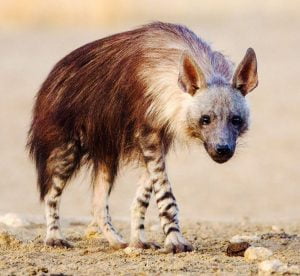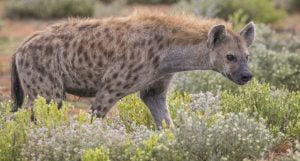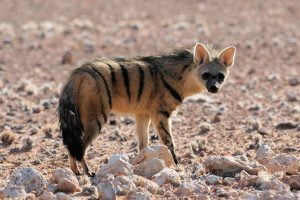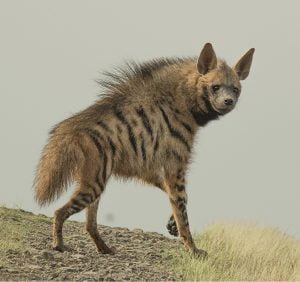Question:
Assalamualaikum ustaz. What is the ruling on eating hyenas? I heard that it was used to be sold between the hills of Safa and Marwah. Hope for an explanation. Thank you.
Answer:
Waalaikumussalam wrt. wbt.,
Alhamdulillah, praise and gratitude to Allah SWT for His countless blessings for us all. Praise and salutations to our beloved Prophet Muhammad PBUH, his family, companions, and all those who follow his footsteps until the Final day.
We begin with the statement of Allah SWT:
وَسَخَّرَ لَكُم مَّا فِي السَّمَاوَاتِ وَمَا فِي الْأَرْضِ جَمِيعًا مِّنْهُ ۚ إِنَّ فِي ذَٰلِكَ لَآيَاتٍ لِّقَوْمٍ يَتَفَكَّرُونَ
“And He has subjected to you whatever is in the heavens and whatever is on the earth – all from Him. Indeed, in that are signs for a people who give thought.” [1]
The above verse shows that Allah SWT has subjected everything that is in the heavens that consisting of the sun, moon, and stars as well as everything on the earth that consists of animals (for food and transportation), plants, ships and others to benefit us all. All these blessings are from only Allah, He grants these matters to you as blessings and His gifts. Hence, only to Him, you should worship (obey) and never associate anything with Him. Indeed, what He has subjected for you are signs and proof which shows His Oneness, for those who reflect on the verses of Allah (signs of His Greatness) and arguments as well as proofs that they learn from. [2]
Definition of hyena (hyaenidae)
Hyenas or also known as hyenas are mammals that are famous for their strange howls like the hilarious people who are attacked by hysteria. Hyenas hunt animals for their food. It also eats the remains of animal carcasses. [3] Meanwhile, according to the 4th Edition of Kamus Dewan, a hyena is a wild animal that eats carcasses. [4] The World Encyclopedia has also given a similar definition of this hyena. [5]
According to Kamaluddin al-Damiri in his book, [6] Hyena is a well-known animal (in Arab society). The female hyena is not referred to as Dab‘ah (ضَبْعَةٌ). This is because the male hyena is referred to as Dib‘an (ضِبْعَان) and the plural is Diba‘in (ضِبَاعِيْن), as are the words sirhan (سِرْحَان) and sirahin (سِرَاحِيْن). While the female hyena is referred to as Dib‘anah (ضِبْعَانَةٌ) and the plural is Dib‘anat (ضَبْعَانَات) or Diba ‘(ضِبَاعٌ). However, Ibn Barri mentions that the female hyena is not known by the name Dib‘anah (ضِبْعَانَةٌ). Moreover, it is quoted from Ibn al-Anbari that the word Dab‘u applies to male and female hyenas.
There are several other names for hyenas such as Ja‘ar (جَعَارٌ), Hafsah (حَفْصَةٌ), and Jil (جِيْلٌ). While the title is like Umm Khinnaur (أُمُّ خِنَّوْر), Umm Tariq (أُمُّ طَرِيق), Ummul Qubur (أم القُبُور), Umm Naufal (أم نَوْفَل), Abu’و نَوْفَل), Abu ‘نَوْفَل), Abu’ نَوْفَل), Abu ‘نَوْفَل), Abu’ نَوْفَل⁇) -Hinbir (أبو الهِنْبِر). In addition, hyenas are also animals that undergo menstruation like rabbits.
In addition, hyenas are animals that love to dig graves due to their strong desire for human flesh. When he saw a man sleeping, he would make a hole under the man’s head, and pounce on his neck. Then he killed the man and drank his blood. It is a despicable animal; no other animal behaves like it except its kind. Hyenas are also considered stupid animals among the Arab community as the Arabic proverb says:
أَحْمَقُ مِنْ ضَبْعٍ
“Dumber than a hyena.”
Habitat of hyenas and their food
The Hyena family consists of four species in three genera. Spotted hyenas are the most common species found in wildlife; while the species of aardwolf hyenas, striped hyenas and brown hyenas are difficult to find due to their small size, and their habit of going out at night and living alone. [7] Briefly, it is as follows: [8]
Brown Hyena
Brown hyenas are found south of the Zambezi River, in southern Africa. The hair on his back is long. His coarse fur was blackish grey with stripes only on his legs. Brown hyenas have a habit of going out at night, and a habit of living alone, as well as being able to walk 25 to 40 kilometres each night in search of food. They live in a small clan consisting of several females, males and baby hyenas.
Although Brown Hyenas are mostly carrion eaters, they are also active in hunting and eating a type of furry seal along the Namibian coast. In more barren areas, Brown Hyena also eat plants such as Tsama (Citrullus lanatus) and gemsbok cucumbers (Acathosicyos naudinianus).

Brown Hyena [9]
Spotted Hyena
Spotted hyenas live in sub -Saharan Africa. Its coarse fur is yellowish grey and black spots. Spotted hyenas have large, strong jaws and strong teeth that can break large bones.
Spotted hyenas live in areas dominated by female hyenas consisting of hyenas that are in contact with each other. Male hyenas migrate and become nomads, breeding when meeting with nearby groups. The spotted hyena is known for its nature of eating the carcasses of animals hunted by lions, but it is also active in hunting prey the size of a zebra. However, it is not known whether it also feeds on plants.

Spotted Hyena [10]
Aardwolf
Aardwolf, on the other hand, is an unusual hyena, which lives in the plains of southern and eastern Africa. It’s not a wolf, but a hyena. It is brown with black stripes, black legs and a thick black hairy tail at the tip. Most hyenas have strong jaws and teeth, but aardwolf teeth are small, weak and cone-shaped. It has a wide and sticky tongue. It has five toes on its front foot and four toes on its back foot. Its size is also smaller than other hyenas. Along his back, there are thick feathers, which he will uphold so that it looks bigger. It can also roar and roar when frightened. The name aardwolf which in Afrikaans means ground wolf is given to this animal because it lives in a hole in the ground. Aardwolf is rarely seen because it only comes out at night.
The aardwolf type hyena is a unique hyena, which has adapted to a special nutritional characteristic, which is to eat plant termites. Termites of this type have a habit of doing activities at night, and this makes it the best opportunity for the aardwolf to find food.
Sometimes, it eats animals such as rats, rotting carcasses and even eggs. Aardwolf prefers to live in dry open areas with short grass, especially in areas of farmland that have dried and hardened.

Aardwolf [11]
Striped Hyena
Striped hyenas live in northern Africa and from Turkey throughout the Middle East to India. It is smaller than a speckled hyena. The fur is grey with black stripes on the body and legs. The Striped Hyena is the fastest-growing hyena. They prefer thick bushes, arid lands and mountains with low trees as well as areas filled with shrubs and thorny trees. The Striped Hyena only comes out at night, and it is the animal that most likes to live alone. Yet it has been seen in small family groups while hunting for food.
Although this type of hyena is mostly a carcass eater, it also actively hunts and eats flying insects, and animals such as small rats, and birds and also catches large-sized prey such as Cape rabbits (Lepuscapensis) and bat-eared foxes (Otocyonmegalotis). Like the War Hive, the Striped Hive also sometimes eats fruits, especially the fruit of mulberry (Balanites sp.).

Striped Hyena [12]
The ruling of eating hyena
Basically, scholars have differing opinions regarding the ruling of eating hyena and it is divided into two opinions. There are scholars who state that its meat is halal to be eaten and there are scholars who are of the opinion that it is prohibited.
Abu Hanifah stated that hyena is prohibited to be beaten. This is also the opinion of Sa‘id bin al-Musayyib and al-Thauri. They argued that hyenas are animals that have fangs and the Prophet PBUH prohibited us from eating any animal that has fangs. [13]
Likewise, al-Zaila’I al-Hanafi stated in his book, that a hyena is an animal where its meat isn’t eaten for it eats carcasses and its meat is foul-smelling due to its diet. Thus, it is included as bad animals – filthy. [14] Allah SWT states:
وَيُحَرِّمُ عَلَيْهِمُ الْخَبَائِثَ
“And prohibits for them the evil,” [15]
While Imam al-Nawawi said that hyena meat is permissible to be eaten and traded. [16] This matter is also stated by Imam al-Syafi’I in his book:
وَلُحُومُ الضِّبَاعِ تُبَاعُ عِنْدَنَا بِمَكَّةَ بَيْنَ الصَّفَا وَالْمَرْوَةِ، لَا أَحْفَظُ عَنْ أَحَدٍ مِنْ أَصْحَابِنَا خِلَافًا فِي إحْلَالِهَا
“Hyena meat was sold between the hills of Safa and Marwah when we were in Mecca. And I don’t know of anyone in our ashab that differed in the opinion that ruled it permissible.” [17]
They argued by presenting the narration of Ibn Abi Ammar who asked Jabir:
الضَّبُعُ صَيْدٌ هِيَ؟ قَالَ: نَعَمْ، قَالَ : قُلْتُ: آكُلُهَا؟ قَالَ: نَعَمْ، قَالَ: قُلْتُ لَهُ: أَقَالَهُ رَسُولُ اللَّهِ صَلَّى اللَّهُ عَلَيْهِ وَسَلَّمَ؟ قَالَ: نَعَمْ
‘Is the hyena game?’ He said: ‘Yes'” He said: “I said: ‘Can it be eaten?’ He said: ‘Yes.'” He said: “I said: ‘Did the Messenger of Allah say that?’ He said: ‘Yes.'” [18]
Imam al-Tirmizi stated that this hadith is hasan sahih and some scholars are of the opinion that it is permissible to eat hyena. This is also the opinion of Imam Ahmad and Ishaq. Furthermore, there is also a hadith narration which states that it is makruh to eat hyena. However, its sanad is weak. Hence, there are scholars who ruled it makruh to eat hyena meat just like the opinion of Ibn al-Mubarak. [19]
Moreover, there is another hadith from Jabir bin Abdullah, he said:
سألْتُ رسولَ اللهِ ﷺ عنِ الضَّبُعِ، فقال: هو صيدٌ، ويجعلُ فيه كَبشٌ إذا صادَهُ المــُحرمُ
“I asked the Messenger of Allah (ﷺ) about the hyena. He replied: It is game, and if one who is wearing ihram (pilgrim’s robe) hunts it, he should give a sheep as atonement.” [20]
The above hadith is clear evidence that shows us that hyena is halal to be eaten, for it is categorized as an animal that is hunted.
Moreover, Kamaluddin al-Damiri al-Syafi‘I also stated that among the evidences that rule it is permissible to eat hyena is because hyena doesn’t eat any food that is infected with infectious disease and can live without using their fangs – which means they can survive without hunting other animals. [21]
Furthermore, Syeikh Daud al-Fatani has listed the hyena as a land animal that is halal to be eaten. [22] However, hyenas meant here are those that have fangs but don’t usually hunt other animals because there are other types of hyenas that have fangs and hunt. [23]
In addition, Imam al-Nawawi also included the names of scholars who hold the opinion that hyena meat is permissible to be eaten. Among them are Imam Ahmad, Daud, Ibn Abi Talib, Ishaq bin Rahuyah, and Abu Thaur as well as numerous other companions and tabiin. [24] Whereas there are others among the companions that permit eating hyena and say that it is a game animal such as Sa‘ad bin Abu Waqqas, Ali bin Abu Talib, Ibn Umar and others.[25]
The reason fanged animals are prohibited except hyena
Basically, the Prophet PBUH prohibited eating any fanged wild animal. This is based on a narration from Abu Tha’labah:
نَهَى النَّبِيُّ صَلَّى اللهُ عَلَيْهِ وَسَلَّمَ عَنْ أَكْلِ كُلِّ ذِي نَابٍ مِنَ السَّبُعِ
“The Messenger of Allah(ﷺ) prohibited the eating of every beast of prey with fang,” [26]
Imam al-Syafi’I further explained this matter by saying that fanged animals that are prohibited to be eaten are animals that hunt their food with their fangs. [27]
Other than that, Syeikh Soleh al-Fauzan said there isn’t any contradiction between the two hadiths; the hadith that ruled it permissible to eat hyenas and the hadith that prohibits all fanged animals. The reason is the hadith that prohibits all fanged animals is general while the hadith that permits eating hyenas is specific. Thus, the specific hadith is prioritized over the general hadith. [28] In other words, the hadith regarding the permissibility of eating hyenas has specified the hadith on the prohibition of eating fanged animals, which is general. Hence, it can be understood that all wild fanged animals are prohibited except hyenas.
Furthermore, Ibn Qayyim al-Jauziyyah explains that an animal is prohibited to be eaten when it fulfils two of these characteristics; it has fangs and is a natural predator such as a lion, wolves and tiger. As for hyenas, they only fulfil one of the two characteristics. However, they aren’t natural predators – don’t hunt other prey as their food – and undoubtedly, fanged animals are more specific compared to just fanged animals. Predators are prohibited to be eaten due to their vicious hunting character. It is also undeniable that the vicious nature when hunting that wolves, lions and tigers share isn’t present in hyenas that one couldn’t state both are similar in terms of their prohibition. Furthermore, hyenas aren’t considered predators lexically or the normal local norm. [29]
Therefore, it is likely that the species of hyena in question is Aardwolf because it is the only hyena whose teeth are weak and not strong. While striped and brown hyenas, we can classify these two species as omnivorous animals because, in addition to eating carcasses, they also eat plants and fruits. In addition, both species are also actively hunting other animals for food. So, it is likely that the only edible hyenas of these two species are those that eat carcasses and plants or fruits and do not hunt other animals as their food. While spotted hyena is not included at all because his natural habit is to hunt and have strong fangs.
Conclusion
According to the above discussion and arguments, in our opinion, it is permissible to eat hyena meat as stated by the majority of scholars such as Imam Ahmad, Daud, Ishaq bin Rahuyah, Abu Thaur, Imam al-Syafi‘i, Imam Nawawi and others. Likewise, the same is stated by other scholars such as Sa‘ad bin Abu Waqqas, Ali bin Abu Talib, Ibn Umar and others.
However, it isn’t clearly stated the type or species of hyenas. But there are scholars who said that hyenas meant here are the ones with fangs but their fangs are weak and they don’t naturally hunt other animals as their main diet. This is as expaliend by Ibn Qayyim al-Jauziyyah in his book, I‘lam al-Muwaqqi‘in.
May Allah SWT grant us all a clear understanding in religion. Amin.
Wallahu a’lam.
[1] Surah al-Jathiyah: 13
[2] See al-Tafsir al-Muyassar, pg. 499.
[3] See : http://prpmv1.dbp.gov.my/Search.aspx?k=aneh&d=8.
[4] See : http://prpm.dbp.gov.my/Cari1?keyword=dubuk&d=73528&.
[5] See Ensiklopedia Dunia, (Terj. DBP), 6/299.
[6] See Hayah al-Hayawan al-Kubra, 2/111-113.
[7]See https://www.sciencedirect.com/topics/immunology-and-microbiology/hyena.
[8] See Ensiklopedia Dunia, (Transl. DBP), 1/3-4 and 6/299; Also see https://www.sciencedirect.com/topics/immunology-and-microbiology/hyena.
[9]Picture taken from https://static.wikia.nocookie.net/creatures-of-the-world/images/d/db/663ba848928d7f7880fab85bf7219007.jpg/revision/latest?cb=20170523192534.
[10] Picture taken from https://en.wikipedia.org/wiki/Spotted_hyena#/media/File:Spotted_hyena_(Crocuta_crocuta).jpg
[11] Picture taken from https://upload.wikimedia.org/wikipedia/commons/0/0b/Proteles_cristatus1.jpg
[12] Picture taken from https://en.wikipedia.org/wiki/Striped_hyena#/media/File:Striped_hyena_(Hyaena_hyaena)_-_cropped.jpg
[13] See Hayah al-Hayawan al-Kubra, 2/113.
[14] See Tabyin al-Haqaiq, 5/295.
[15] Surah al-A‘raf: 157
[16] See al-Majmu‘ Syarh al-Muhazzab, 9/9.
[17] See al-Umm, 2/273.
[18] Narrated by al-Tirmizi (1791)
[19] See Sunan al-Tirmizi, 4/252.
[20] Narrated by Abu Daud (3801)
[21] See Hayah al-Hayawan al-Kubra, 2/113.
[22] See Matla‘ al-Badrain, (arranged by PMWP), pg. 26.
[23] See Matla’ al-Badrain, (arranged by PMWP), footnote no. 13, pg. 26
[24] See al-Majmu‘ Syarh al-Muhazzab, 9/9.
[25] See Musannaf ‘Abd al-Razzak, 4/512-513.
[26] Narrated by Muslim (1932)
[27] See al-Umm, 2/272.
[28] See al-At‘imah, pg. 40.
[29] See I‘lam al-Muwaqqi‘in, 2/90.
